تُعد إدارة علاقات العملاء (CRM) مجالًا أساسيًا يجب إتقانه إذا كنت تبحث عن نمو أعمالك بشكل عام. وفقًا لدراسة استقصائية أجرتها ستيلا كونيكت ، 50% من المستهلكين يعطون الأولوية لخدمة العملاء عند الاختيار بين العلامات التجارية.
يتفق معظم المديرين على أن لوحة كانبان هي السر في تصور وإدارة سير عمل إدارة علاقات العملاء والعملاء والعملاء المحتملين عبر مراحل مختلفة في خط أنابيب المبيعات. Pipedrive و Trello هما أداتان من أفضل الأدوات المتاحة على غرار كانبان، ولكن هل إحداهما أفضل من الأخرى؟
للوهلة الأولى، يبدو للوهلة الأولى أنهما متشابهتان إلى حد كبير - تصميم السحب والإفلات، ومئات من عمليات التكامل، و خيارات إدارة المهام يمكن أن تعزز كفاءة فريقك. لكن تعمق أكثر، وسترى أن كلتا الأداتين تخدمان أغراضاً فريدة لفرق التسويق والمبيعات.
سنرتدي قبعاتنا البوليسية غير المتحيزة ونأخذك في رحلة Pipedrive مقابل Trello. راجع مقارنتنا الشاملة للميزات وحدد الفائز في برنامج إدارة المشاريع.
ومن يدري، قد تكتشف بديلاً خارقًا يمكن أن يلبي جميع احتياجاتك برنامج إدارة علاقات العملاء وإدارة المشاريع الاحتياجات على طول الطريق. ⭐
ما هو Pipedrive؟
Pipedrive هي أداة شائعة قائمة على السحابة أداة إدارة علاقات العملاء (CRM) تركز على المبيعات. وهي مزودة بميزات لتصور وتخصيص و إدارة خطوط أنابيب المبيعات وتحسين تجربة العملاء، وتعزيز تجربة العملاء، وتعزيز تعاون الفريق . 😍
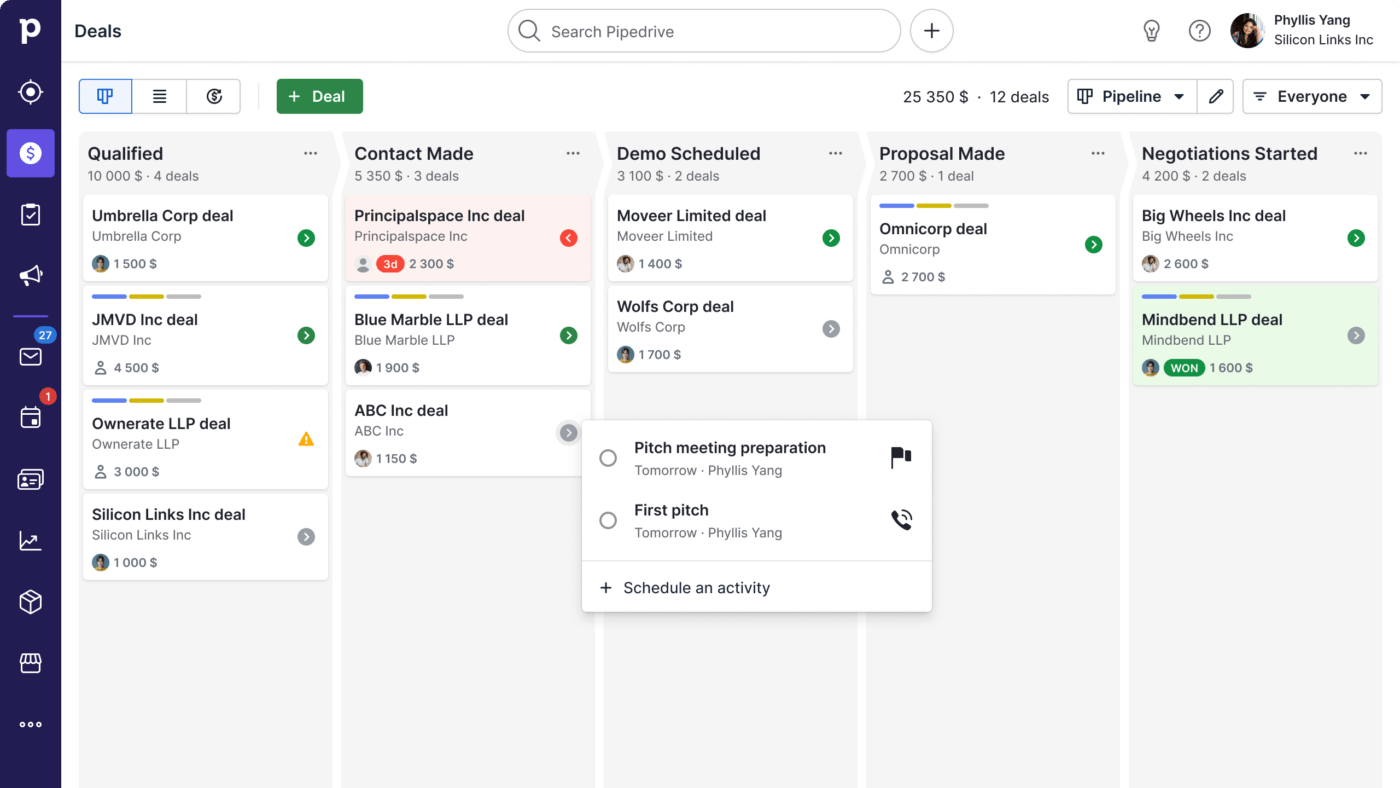
عبر: Pipedrive تحب Pipedrive لوحات Kanban - فهي تتيح لك إنشاء لوحات مخصصة لخطوط الأنابيب وتمثيل كل مرحلة كبطاقات (أو صفقات) قابلة للنقل بإجراءات سحب وإفلات بسيطة. استخدمها لتخطيط خطوات المبيعات وتتبعها رحلات العملاء من خلال حالات مختلفة.
يحتوي معالج CRM على خيارات ممتازة لتصفية العملاء المحتملين وتقسيمهم، وستكشف لك نظرة عامة واحدة على لوحتك عن موقفك مع العملاء المحتملين المختلفين في خط أنابيب المبيعات. يمكنك تتبع المشاريع بسهولة في عرض التقويم الخاص به، والذي يتيح للمستخدمين أيضًا استخدام Pipedrive على أفضل وجه كأداة تعاون حقيقية.
باستخدام هذه الأداة القوية، يمكنك إنشاء تجارب مخصصة لعملائك. أتمتة المهام، ومساعد المبيعات المدعوم بالذكاء الاصطناعي، وميزات توليد العملاء المحتملين, التسويق عبر البريد الإلكتروني ، وروبوتات الدردشة الآلية ليست سوى بعض الخيارات التي تجعل سير عملك أكثر كفاءة وتوفر لك الوقت.
ميزات Pipedrive
ما الذي يجعل Pipedrive مشهورًا جدًا؟ دعنا نتحقق من أبرز ميزاته.
1. أتمتة المبيعات
إذا سألت مندوبي المبيعات عن سبب حبهم ل Pipedrive، نراهن أن الكثيرين سيبدأون في الثناء على أتمتة المبيعات الخيارات. تدرك هذه الأداة التحديات التي يواجهها مندوبو المبيعات، مثل الإدارة المملة وإدارة العملاء المحتملين والتنبؤ بخط أنابيب المبيعات. ولكن هذه الأداة تساعد في التغلب عليها من خلال ميزات الأتمتة القوية (متوفرة في الخطط المتقدمة والعليا).
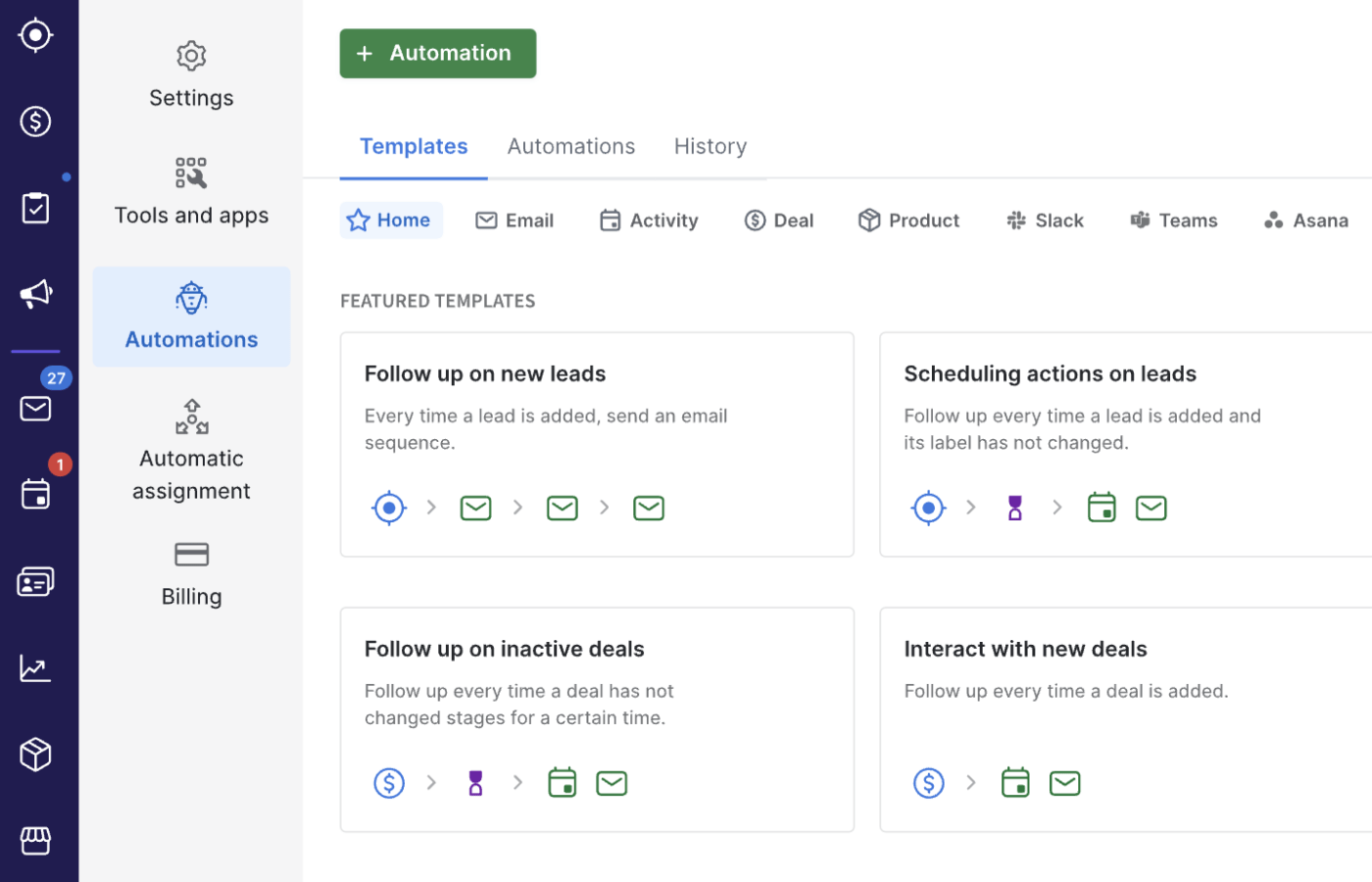
عبر Pipedrive
يمكنك أتمتة أي جزء من عملية المبيعات تقريبًا. أرسل رسائل بريد إلكتروني مخصصة إلى العملاء المحتملين، وتابع الصفقات غير النشطة، وانقل الصفقات عبر خط الإنتاج، وتوقع الإيرادات ببضع نقرات فقط. يتيح لك Pipedrive تخصيص عمليات الأتمتة الخاصة بك مع أحداث التشغيل والإجراءات. يمكنك أيضًا الوصول إلى أتمتة سير العمل قوالب لتسهيل العملية!
2. خيارات قوية لإعداد التقارير
كل تحتوي أداة إدارة علاقات العملاء على خيارات إعداد التقارير فلماذا هذه الميزة البارزة في Pipedrive؟ حسنًا، تخطو المنصة خطوة إلى الأمام وتسمح لك بفهم العلاقات مع عملائك وتعزيزها والاستفادة من المعلومات لتنمية أعمالك.
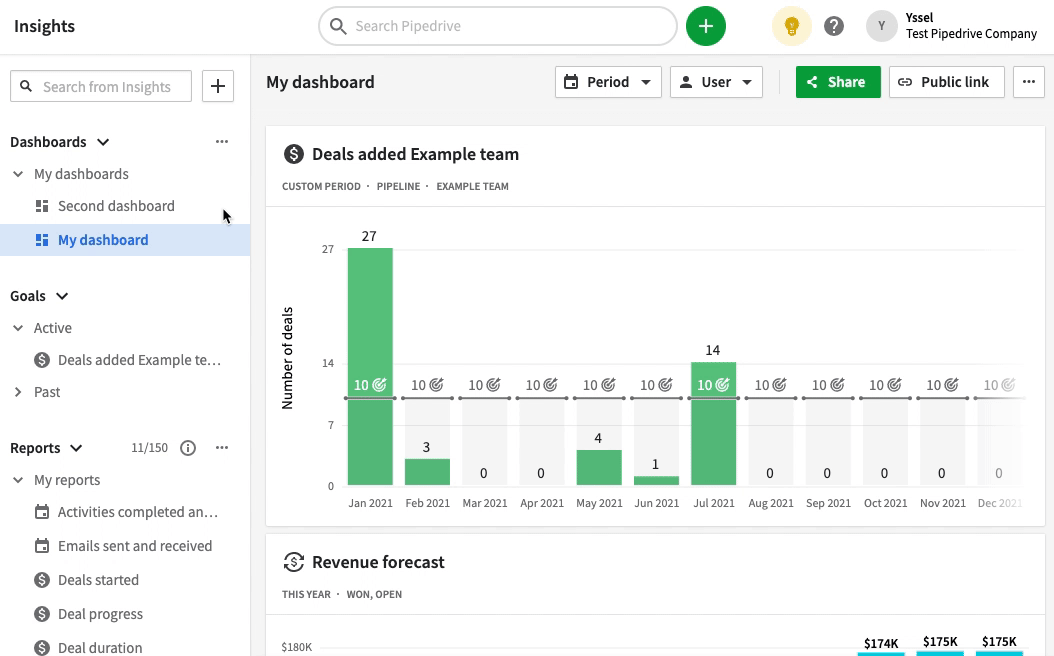
عبر Pipedrive
تحتوي الأداة على لوحة معلومات Insights فريدة من نوعها لمساعدتك في تحديد اتجاهات العملاء من خلال مجموعة من التقارير المعبأة بصريًا. من خلال المقاييس والرسوم البيانية المتاحة، يمكنك التعرف على الاختناقات وتحديد الأنماط الرابحة من أجل الحملات التسويقية .
تعد خيارات إعداد التقارير الخاصة بالأداة مفيدة بشكل خاص عند التخطيط للمبيعات و استراتيجيات إدارة علاقات العملاء . من خلال بيانات ذكاء الأعمال حول سرعة الصفقات وأهداف الإيرادات، يمكنك وضع تنبؤات دقيقة وقرارات مستنيرة حول كيفية المضي قدمًا. 💯
3. إضافات إدارة علاقات العملاء
يتيح لك Pipedrive تزويد شركتك بقوى خارقة لإدارة علاقات العملاء بفضل الوظائف الإضافية المصممة لتعزيز الإنتاجية والتعاون و إدارة سير العمل .
الوظيفة الإضافية الشائعة هي LeadBooster، وهي تتيح لك التقاط العملاء المحتملين وإشراكهم من خلال مساعدة روبوتات الدردشة والدردشة المباشرة ونماذج الويب.
إذا كنت ترغب في معرفة كيفية تفاعل الزائرين مع موقعك الإلكتروني، فاستخدم الوظيفة الإضافية زوار الويب. فهي تعرض من يزورون موقعك الإلكتروني، ومدة بقائهم على موقعك الإلكتروني، وأكثر ما يتفاعلون معه.
من الإضافات القيّمة الأخرى المستندات الذكية، وهي مركز مركزي لإدارة المستندات مثل العروض وعروض الأسعار والعقود.
تسعير Pipedrive
- أساسي: 9.90 دولار شهريًا لكل مستخدم
- متقدم: 19.90 دولارًا شهريًا لكل مستخدم
- احترافي: 39.90$/شهرًا لكل مستخدم
- قوي: 49.90$/شهرًا لكل مستخدم
- المؤسسات: 59.90$/شهرياً لكل مستخدم
* تشير جميع الأسعار المدرجة إلى نموذج الفوترة السنوية
ما هو Trello؟

عبر: تريلو يتمحور Trello حول عرض اللوحة. منصة إدارة المشاريع هذه تستخدم لوحات كانبان كواجهة رئيسية لإدارة بطاقات Trello. تساعدك المنصة على إنشاء وإدارة مهام سير العمل، وتنسيق الفرق، وضمان اكتمال كل مشروع في الوقت المحدد بأقل قدر من العوائق.
أفضل ما في Trello هو تعدد استخداماته - مع تعديلات طفيفة, أدوات إدارة المشاريع مثل هذه يمكن أن تصبح مركزًا قويًا لإدارة علاقات العملاء. بالإضافة إلى ذلك، تُعد Trello مناسبة في مختلف المجالات، سواء كانت مالية أو صحية أو غير ربحية.
تتمحور المنصة حول توفير الوقت. فباستخدام بوتلر، أداة الأتمتة المدمجة في تريللو، يمكنك تعيين القواعد وضمان عدم سقوط أي مهمة في الشقوق. قم بتعيين المشغلات والإجراءات المطلوبة، وشاهد Trello وهو يقوم بالأعمال الشاقة نيابةً عنك بينما تركز على شيء آخر. يستطيع بتلر حتى اكتشاف العمليات المتكررة واقتراح الأتمتة المتاحة.
يضمن تصميم السحب والإفلات في المنصة الإبحار بسلاسة عبر لوحات كانبان ويجعل إدارة المهام نسيم
ميزات Trello
يوفر Trello العديد من الإمكانيات الملائمة لإدارة علاقات العملاء. دعنا نتحقق من بعض الميزات الجديرة بالملاحظة.
1. اللوحات والقوائم والبطاقات
الكلمات السحرية الثلاث التي يعيش بها Trello هي اللوحات والقوائم والبطاقات. فهي تساعدك في الحصول على نظرة عامة واضحة على مشاريعك وتتبع أعباء عمل الفريق والتقدم المحرز.
تعمل لوحات Trello كموطن لكل مشروع مباشر. هذا هو المكان الذي تضيف فيه المهام وتفرزها وتنقل الأشياء للحفاظ على مساحتك محدثة وخالية من الفوضى.

عبر Trello
تحتوي كل لوحة من لوحات Trello على قوائم تمثل مراحل مختلفة من مهامك، مثل المهام التي يجب القيام بها، والمهام قيد التنفيذ، والمهام قيد المراجعة، والمهام المنجزة لإدارة المشاريع بشكل أفضل. تمنحك القوائم نظرة عامة سريعة على تقدم المشروع، مما يساعدك على تحديد الأولويات وتخصيص سير العمل.
تمثل البطاقات المهام المفردة، وتتوسع في التفاصيل مثل المُعيَّن وتاريخ الاستحقاق والوصف والمرفقات. قم بفرز بطاقاتك عبر القوائم عن طريق السحب والإفلات وضمان تنظيم لا تشوبه شائبة.
2. طرق عرض متعددة للمشروع
يمكن أن يساعدك تغيير المنظور في اكتشاف مخاطر المهام وأوجه القصور والتوصل إلى طرق لتحسين عمليات إدارة مشروعك.
يجعل Trello هذا الأمر ممكنًا من خلال طرق عرض متعددة للمشروع - سبع طرق عرض على وجه الدقة. تشتهر الأداة بطريقة عرض اللوحة الخاصة بها، وهي طريقة عرض على غرار كانبان تعرض مهامك المتعلقة بالمشروع بالكامل كبطاقات، لكن مستخدمي Trello يستمتعون أيضًا بتخطيطات أخرى.
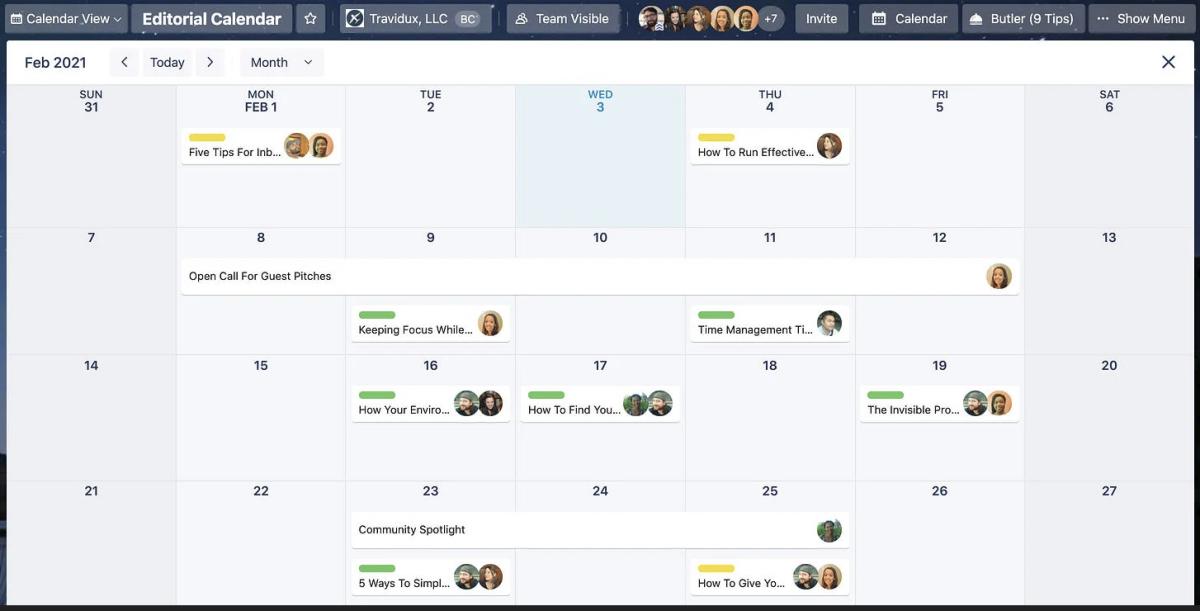
عبر Trello
على سبيل المثال، لديك عرض التقويم والجدول الزمني لتصور تواريخ الاستحقاق والجداول الزمنية وأعباء العمل. العب بنقاط بيانات مختلفة في عرض لوحة المعلومات وحلل البطاقات حسب تاريخ الاستحقاق أو عضو الفريق أو القائمة أو التسمية.
3. القوالب
يقدم Trello المئات من القوالب المعدة مسبقًا لمساعدتك أنت وفريقك في الوصول إلى النجوم! لراحتك، تقوم المنصة بتصنيف القوالب إلى فئات متعددة.
استخدم قوالب إدارة المشاريع لإنشاء مهام سير العمل، وتتبع الاجتماعات، وتنظيم المهام المعلقة، ووضع علامة على المهام على أنها منجزة للشعور بالنجاح المطلق! 😌
استكشف مجموعة قوالب المبيعات في Trello للعثور على خيارات تركز على إدارة علاقات العملاء. على سبيل المثال، استخدم قالب خط أنابيب CRM لفرز العملاء المحتملين, إدارة جهات الاتصال المعلومات، ومركزة الموارد للسماح للمستخدمين بالتنقل بين خطوط الأنابيب. يعد لوحة نجاح العميل نموذجًا قويًا آخر مع طرق عرض دقيقة لكل حساب عميل.
تسعير Trello
- مجاني الإصدار
- قياسي: 5 دولارات شهريًا لكل مستخدم
- قسط: 10 دولارات شهريًا لكل مستخدم
- المؤسسة: 17.50 دولار/شهرياً لكل مستخدم
\ * تشير جميع الأسعار المدرجة إلى نموذج الفوترة السنوي
Pipedrive مقابل. Trello: مقارنة الميزات
كل من Pipedrive و Trello أداتان مفيدتان تستفيدان من لوحات Kanban لتحقيق الكفاءة في سير العمل وتنظيم العمليات وتسهيل التعاون. ومع ذلك، فإن الأداتين تختلفان في العديد من الجوانب المهمة، وعلى رأسها استخدامهما الأساسي. Pipedrive هو خبير في إدارة علاقات العملاء بلوحة كانبان يركز على المبيعات، بينما Trello هو أداة لإدارة المشاريع - مما يسمح للمستخدمين بسحب وإسقاط البطاقات لسير العمل بشكل أسرع.
ومع ذلك، تتداخل استخداماتهما إلى حد ما-تتمتع Pipedrive ببعض إمكانيات إدارة المشاريع، ويمكن استخدام Trello كمنصة لإدارة علاقات العملاء. دعونا نجري مباراة بين Pipedrive و Trello من ثلاث جولات ونرى أيهما الفائز! 🥇
1. الأتمتة
يصمد كلا المتنافسين بشكل جيد في هذا المجال مع ميزات أتمتة رائعة لسيناريوهات _إذا-ثم-. يركز Pipedrive على المبيعات، لذا فإن معظم خيارات الأتمتة تدور حول إنشاء وتعيين العملاء المحتملين وتسريع العمل الإداري مثل تخزين جهات الاتصال. يقدم حاليًا 36 قالب أتمتة مُعد مسبقًا.
يقدم Trello خيارات أتمتة أكثر عمومية للحفاظ على لوحات كانبان خالية من الفوضى. قد تمنحه ميزة بتلر ميزة على Pipedrive. يدعم بتلر الأتمتة بدون تعليمات برمجية مع أوامر سهلة الاستخدام وقائمة غنية، حتى أنه يقترح إضافة سريعة للأتمتة للمهام المتكررة.
هذا مناسب بشكل لا يصدق للمبتدئين الذين يكافحون لتحديد ما يجب أتمتته أو كيفية القيام بذلك.
إجمالاً، كلتا الأداتين من الدرجة الأولى في لعبة الأتمتة، ولكن قد يكون لـ تريلو اليد العليا هنا بسبب أداة بتلر المخصصة.
2. التعاون والتواصل
يُعد العمل الجماعي والتواصل الشفاف أمرًا حيويًا لكل شركة، ويدرك كل من مطوري Pipedrive وTrello ذلك جيدًا. ومع وضع ذلك في الاعتبار، تسمح لك هذه المنصات بترك التعليقات وطرح الأسئلة والعمل في الوقت الفعلي مع زملائك في العمل، بغض النظر عن الموقع.
الفرق؟ يحتوي Pipedrive على خيارات اتصال خارجية أكثر قوة وموجهة نحو إدارة علاقات العملاء. يتيح لك Pipedrive التحقق من عملائك ومتابعة عملائك المحتملين ببضع نقرات.
نظرًا لكونه أداةً للمدراء التنفيذيين، فإن Trello يركز أكثر على التواصل الداخلي -يمكنك ترك تعليقات على بطاقات المهام واستخدام الإشارات وتدوين الملاحظات. حتى أن المنصة تحتوي على قوالب تعمل على تبسيط التعاون. على سبيل المثال، تساعدك لوحة التعاون على تحديد أولويات المشاريع ومناقشتها مع زملائك في العمل في بيئة غير رسمية في Pipedrive.
في حين أن كلا المنتجين يدعمان فرق العمل عن بُعد، قد يجذبك Pipedrive أكثر من حيث أدوات التواصل التي تمكّن المبيعات مثل التسويق عبر البريد الإلكتروني والتتبع. 📧
3. التكامل
يمكن أن يؤدي التكامل مع أدوات العمل الأخرى إلى توسيع وظائف أي منصة، لذلك ليس من المستغرب أن يقدم كل من Pipedrive و Trello الكثير من الخيارات.
من حيث عدد عمليات التكامل، يفوز Pipedrive - فهو يقدم أكثر من 400 عملية تكامل، بينما يتراجع Trello بأكثر من 190 عملية تكامل.
نظرًا لأن Pipedrive أكثر توجهاً نحو المبيعات، فإنه يقدم تكاملات مع منصات للتسويق عبر البريد الإلكتروني، وتوليد العملاء المحتملين، والعروض والعقود، والمحاسبة والفواتير.
لدى Trello مجموعة من عمليات التكامل الأكثر عمومية لحالات الاستخدام مثل:
- إدارة الملفات
- الموارد البشرية والعمليات
- المنتج والتصميم
- المبيعات والدعم (يتضمن خيارات مثل noCRM.io و Salesforce)
على الرغم من أن الكرة في ملعب Pipedrive عندما يتعلق الأمر بعدد عمليات التكامل، إلا أننا نقول إنه تعادل. ذلك لأن Trello هي شركة تابعة لعملاق البرمجيات Atlassian وتتكامل بسلاسة مع المنتجات الشقيقة مثل Jira و Confluence.
Pipedrive مقابل. Trello على رديت
يتمتع جمهور ريديت البارع في مجال التكنولوجيا بمصداقية كبيرة عندما يتعلق الأمر بمناقشات البرمجيات. لقد تحققنا من بعض المواضيع لنرى كيف يشعر مستخدمو ريديت حول Pipedrive و Trello كأدوات لإدارة علاقات العملاء.
بالنسبة للجزء الأكبر، يعتقد المستخدمون Pipedrive هو أداة إدارة علاقات العملاء اللائقة للشركات الصغيرة . هذا مقتطف من موضوع
"يعمل بشكل جيد جدًا للشركات الصغيرة والمتوسطة بين الشركات، ولكن المنظمة البحرية الدولية لا تسمح بالنمو القابل للتطوير. مقيّد من حيث إعدادات الأذونات ومقدار الميزات التي يمكنك أتمتتها."
يعتقد بعض المستخدمين أن Trello خيار جيد لإدارة علاقات العملاء على الرغم من أن هذا ليس غرضه الأساسي:
"لا يوصى باستخدام Trello أبدًا كإدارة علاقات العملاء، وهذا أمر مفهوم لأنه لم يتم الإعلان عنه لذلك. ومع ذلك أعتقد أنه يعمل بشكل رائع كإدارة علاقات العملاء باستخدام الإصدار المتميز حيث يمكن إضافة حقول مخصصة، ثم الاحتفاظ بعرض كانبان بسيط للعملاء المحتملين الجدد > العملاء المحتملين الذين تم الاتصال بهم > العملاء المحتملين الساخنين > العملاء المحتملين المغلقين / المفقودين." موضوع آخر يقول
"أتمنى لو يمكن تحويل Trello بطريقة ما إلى إدارة علاقات العملاء بسهولة. سيكون ذلك رائعًا. ولكن حتى الآن لا أرى الأمر كذلك...""
تعرف على ClickUp: أفضل بديل لـ Pipedrive مقابل. Trello
استكشف أكثر من 15 طريقة عرض، بما في ذلك لوحات كانبان الشاملة، في ClickUp لتخصيص سير عملك وفقًا لاحتياجاتك
عند الاختيار بين Pipedrive وTrickllo، فأنت في الأساس تقوم بحل وسط. أحدها مثالي لإدارة علاقات العملاء الموجهة نحو المبيعات ولكنه يفتقر إلى خيارات متقدمة لإدارة المشاريع، بينما الآخر هو قوة إدارة المشاريع ولكنه ليس الخيار الأفضل لإدارة العملاء.
ماذا لو قلنا لك أنه ليس عليك تقديم تنازلات؟ يمكنك الحصول على أفضل ما في العالمين مع انقر فوق ، أداة شاملة تساعد شركتك على الازدهار من خلال وظائف إدارة علاقات العملاء وإدارة علاقات العملاء المتطورة.
من إدارة العملاء المحتملين ورعاية العلاقات مع العملاء الحاليين إلى التعامل مع الاتصالات الداخلية والمشاريع من جميع الأنواع والأحجام، يمكن ل ClickUp أن يحوّل عملياتك.
إليك لمحة سريعة عن الميزات الرائعة التي تجعل من ClickUp أداة pipedrive ممتاز و بديل Trello .
1. تصور العمليات الخاصة بك وقم بإدارتها بشكل دقيق باستخدام لوحات كانبان الغنية

قم بإضافة نقاط سريعة ومكلفين متعددين ومرفقات وعلامات والمزيد إلى لوحة كانبان الخاصة بك في غضون نقرات في طريقة عرض لوحة ClickUp
يقدم ClickUp أكثر من 15 عرض مشروع أحدها يتعلق ببطاقات على غرار كانبان. مع لوحات كانبان ClickUp يمكنك إدارة خطوط أنابيب المبيعات وفرز العملاء المحتملين والحاليين إلى فئات قابلة للتخصيص. قم بتقسيم المشاريع المرهقة إلى بطاقات مهام يمكن إدارتها وتمثيلها بناءً على حالتها أو تاريخ استحقاقها أو أي معيار آخر تختاره.
لوحات كانبان من ClickUp Kanban هي سهلة الاستخدام، بفضل واجهة السحب والإفلات لنقل البطاقات على طول القوائم. قم بإنشاء خطوط أنابيب متعددة مخصصة بمراحل مثل تم الاتصال، مهتم، مهتم، مفاوضة، صفقة مغلقة. أضف مكلفين بالمهام، وحدد الأولويات وتواريخ الاستحقاق، وقم بفرز وتصفية مهام سير العمل.
هل تتعامل مع لوحات متعددة؟ استخدم طريقة عرض كل شيء للحصول على نظرة عامة مركزية شاملة لجميع لوحات كانبان الخاصة بك.
قد يكون تحرير مهام متعددة أمرًا مملًا، لذلك ابتكر ClickUp شريط أدوات العمل الشامل. استخدمه لتحديث عدة مهام في وقت واحد دون مغادرة اللوحة. مع أتمتة ClickUp ، يمكنك أتمتة جميع أنواع الأعمال الروتينية، بما في ذلك تعيين المهام بناءً على موقع العميل المحتمل، وتحديث الحالات، وإرسال رسائل البريد الإلكتروني إلى العملاء المحتملين. اختر من بين أكثر من 100 خيار روتيني أو قم بإنشاء خياراتك الخاصة.
لوحات كانبان هي صديقة للتعاون ومدعوم أيضًا على تطبيق ClickUp للجوال . ما عليك سوى إضافة فريقك إلى اللوحات والتعاون باستخدام الإشارات ومواضيع الثناء, اللوحات الرقمية والتدقيق، من بين أدوات أخرى.
2. عزز علاقاتك مع العملاء باستخدام ClickUp CRM

إدارة بيانات العملاء والمهام الشخصية والاتصالات في ClickUp من أي جهاز
ClickUp مثل الحرباء - فهو يتكيف مع متطلبات الأعمال المختلفة. تريد استخدامه لقوته ميزات إدارة المشاريع ? هذا جيد! ولكن إذا كنت تبحث عن مجموعة شاملة لإدارة علاقات العملاء، فإن ClickUp يقدم لك ذلك بالتأكيد. ✌️ ClickUp CRM هو كل شيء عن تسريع نمو العملاء ورضاهم من خلال إدارة خطوط الأنابيب والحسابات المصممة خصيصًا. ميزاته المجمعة مناسبة للشركات الناشئة والشركات الكبيرة على حد سواء.
يمكنك استكشاف عديد من طرق العرض المرنة لمراقبة العملاء المحتملين والحسابات والطلبات والفواتير ورحلات العملاء. التقط بيانات العملاء باستخدام نماذج ClickUp واستخدم الحقول المخصصة لإدارة معلومات الاتصال.

قسّم الأهداف والمهام والنقاط الرشيقة وحالات المشروع في لوحة معلومات ClickUp 3.0 القابلة للتخصيص بدرجة كبيرة
انتقل إلى لوحات المعلومات مع أكثر من 50 عنصر واجهة مستخدم وأدوات إعداد التقارير لتحليل بيانات العملاء واكتساب رؤى قيّمة حول العمليات التي تعمل بشكل جيد وتلك التي يمكن تحسينها.
جرّب برنامج ClickUp المثير للإعجاب إدارة البريد الإلكتروني خيارات لمتابعة العملاء المحتملين وإرسال معلومات المشروع إلى العملاء والتعاون بسهولة. الاندماج مع أكثر من 1000 أداة عمل لتبسيط العمليات اليومية.
3. وفِّر الوقت وزد من قوتك مع قالب ClickUp CRM
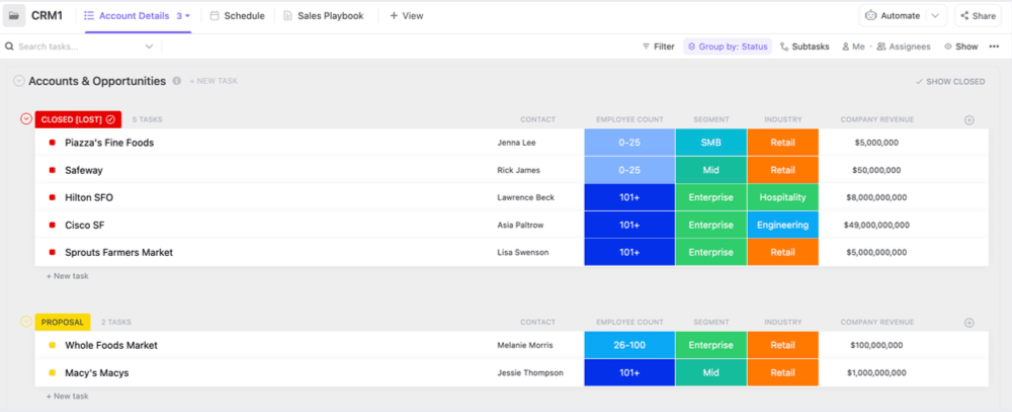
إدارة العملاء وخطوط المبيعات وعناصر الإجراءات والمزيد باستخدام قالب إدارة علاقات العملاء البسيط من ClickUp في عرض القائمة
عروض ClickUp أكثر من 1,000 قالب لأغراض مختلفة. اختر من بين مجموعة مختارة من لوحة كانبان و إدارة العملاء قوالب لإبقاء فريقك متحركاً. بالنسبة لإدارة خط الأنابيب المتكامل، هناك نموذج لا يجب أن تتردد في تجربته: نموذج قالب ClickUp CRM .
هذا القالب هو مركز مركزي لكل ما يتعلق بخطوط الأنابيب وعلاقات العملاء. يوفر العديد من طرق العرض المصممة من قبل الخبراء لتنظيم المعلومات.
على سبيل المثال، تتيح لك طريقة عرض تفاصيل الحساب إنشاء قائمة بحساباتك وفرصك وفرزها حسب الحالة: مغلق، اقتراح، عرض، عرض تجريبي، و محتمل مؤهل. قدم معلومات حول إدخالاتك باستخدام خمسة حقول مخصصة:
- جهة الاتصال
- عدد الموظفين
- القطاع
- القطاع
- إيرادات الشركة
ستحب طريقة عرض الجدول الزمني - فهي تعرض تقويمًا يغطي المواعيد والمهام والأحداث المرتبطة بإدارة علاقات العملاء.
استفد من عرض دليل المبيعات لتلخيص سياسات الشركة وقواعد إدارة المبيعات والعملاء. وهي ذات قيمة خاصة عند تدريب الموظفين الجدد. 🥰
أفضل أدوات إدارة المشاريع؟ ClickUp لديها كل شيء
لم يتم إنشاء جميع المنصات على قدم المساواة - لماذا ترضى ب الجيد بما فيه الكفاية بينما يمكنك الحصول على الأفضل؟ ClickUp هو حل برمجي قوي لكلٍ من مديري المشاريع وفرق المبيعات، وأروع ما في الأمر أنه يحتوي على خطة مجانية سخية! سواء كان ذلك للفرق الكبيرة أو الصغيرة، فإن ClickUp هو أداة التعاون المثالية لجميع الفرق.
فهو يدعم عددًا غير محدود من المهام والأعضاء، ويوفر مستندات تعاونية، كما أنه يحتوي على ذكاء اصطناعي أصلي مساعد جرب نسخته المجانية اليوم وشاهد كيف يرتقي بعلاقاتك مع العملاء! 🌞

